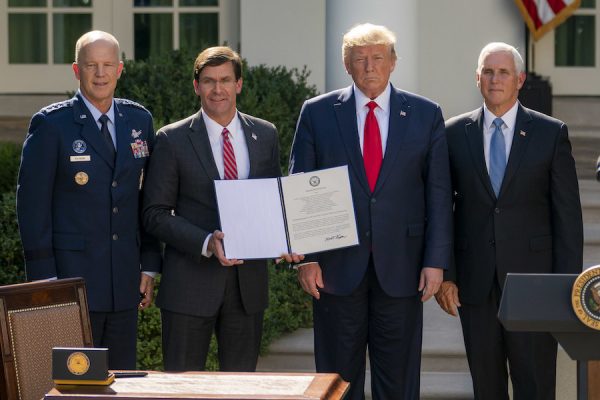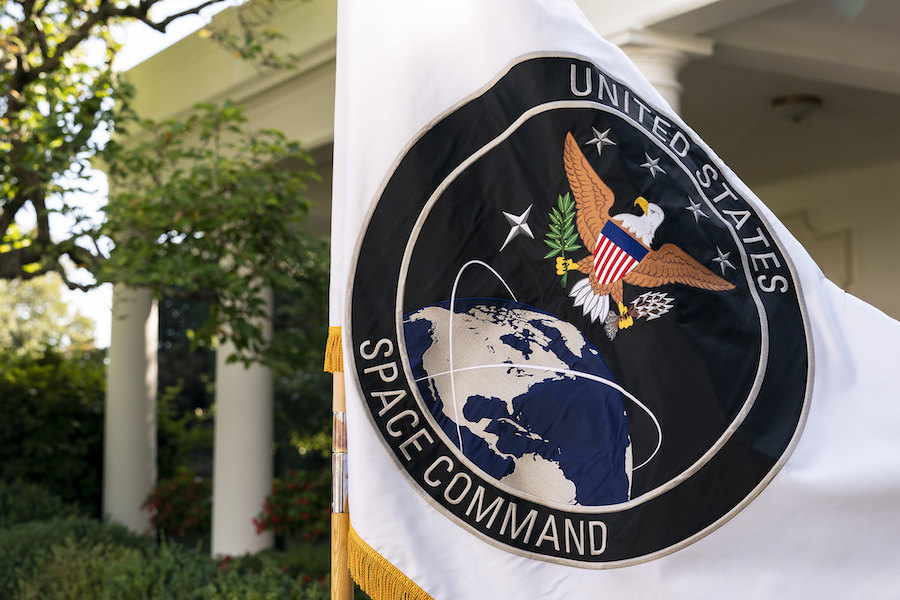Trump reauthorizes US Space Command – Spaceflight Now

President Trump reestablished U.S. Space Command in a White House ceremony Thursday, setting up a unified combatant command previously dissolved in 2002 that Trump said “will defend America’s vital interests in space” amid growing threats to space assets and services.
The establishment of Space Command is a step short of the Trump administration’s goal of setting up the U.S. Space Force as a sixth branch of the military. That move requires congressional approval.
“As the newest combatant command, SPACECOM will defend America’s vital interests in space, the next warfighting domain,” Trump said. “And I think that’s pretty obvious to everybody. It’s all about space.”
Gen. Jay Raymond, the current head of Air Force Space Command, is the first leader of the reborn U.S. Space Command, which was merged with Strategic Command in a Defense Department reorganization after the Sept. 11 terrorist attacks.
The new Space Command will be independent of Strategic Command, which also oversees nuclear forces. Raymond will remain in his role at Air Force Space Command.
“The scope, scale and complexity of today’s threat is real and it is concerning,” Raymond said during the establishment ceremony Thursday. “The establishment of a combatant command solely focused on the space domain, demonstrates the United States’ commitment to protecting and defending its space assets against that threat.”
Space Command is the second new combatant command set up during the Trump administration. The Defense Department set up Cyber Command last year to oversee offensive and defensive cyber operations. Space Command becomes the 11th combatant command in the U.S. military.
“Our adversaries are weaponizing Earth’s orbits with new technology targeting American satellites that are critical to both battlefield operations, and our way of life at home,” Trump said Thursday. “Our freedom to operate in space is also essential to detecting and destroying any missile launched against the United States.
“So just as we have recognized land, sea, air and cyber as vital war fighting commands, we will now treat space as an independent region overseen by a new unified geographic combatant command,” Trump said.

Space Command’s “area of responsibility” is defined as the area surrounding the Earth at or above 100 kilometers, or about 62 miles, above sea level.
“Our space capabilities underpin the security of our great nation, enable our economic prosperity, provide for our way of life, and secure our way of war,” Raymond said. “In fact, there is nothing we do as a joint and coalition force that isn’t enabled by space. Our adversaries understand this and are moving fast to develop their own robust space capabilities and to develop weapons designed to deny us the use of space and the advantage they provide.
“This afternoon, by establishing United States Space Command, singularly focused on that warfighting domain, we send a very clear message to the world that the United States and our allies will not assume away space superiority,” Raymond said.
U.S. Space Command will be temporarily led out of Peterson Air Force Base, Colorado. Military officials will pick a permanent headquarters later, with candidate sites identified in Alabama, Colorado and California.
During a National Space Council meeting Aug. 20, military and Trump administration officials discussed the role of Space Command, and a possible future Space Force.
Gen. Joseph Dunford, chairman of the Joint Chiefs of Staff, said the military will “immediately” assign 87 units under the command of Gen. Raymond after the establishment of Space Command.
“This step will put us on a path to maintain a competitive advantage … in this critical warfighting domain,” Dunford said Aug. 20. “When Gen. Raymond assumes command, he’s going to bring together capabilities that include missile warning, satellite operations, space control and space support.”
The National Reconnaissance Office, which owns the government’s fleet of spy satellites, will not be a part of Space Command or the Space Force. But the NRO is tightening its relationship with the military to “align U.S. Space Command and NRO into a new unified defense concept of operations at the National Space Defense Center,” said Joseph Maguire, the acting director of national intelligence.
Maguire described the National Space Defense Center, located at Schriever Air Force Base in Colorado, as the “center of gravity” for defending U.S. national security interests in space. The center was formerly named the Joint Interagency Combined Space Operations Center, or JICSpOC, before receiving its new name in 2017.
“Furthermore, should conflict extend to space, the NRO will take direction from the commander of U.S. Space Command and execute defense operations based on a jointly-developed playbook, and informed by a series of exercises and war games,” Maguire said Aug. 20.
Maguire said China has deployed a ground-based missile intended to destroy satellite in low Earth orbit, and Russia is working on a similar system that will likely be operational in the next few years.
“China is pursuing weapons capable of destroying satellites up to geosynchronous Earth orbit, and Russia has fielded a ground-based laser weapon, which could blind or damage our space-based optical sensors,” Maguire said.
While Space Command is focused on operations and aggregates units from across the Defense Department’s existing services, the Space Force — if established — would be authorized to organize, train and equip military units as a separate uniformed service.
The Democratic-controlled House of Representatives and the Republican-led Senate both have provisions for a Space Force in their annual defense bills. The next step will be to reconcile differences between each house’s proposed Space Force plan.
In both congressional bills, the Space Force would become part of the Department of the Air Force, similar to the way the Marine Corps is a component of the Department of the Navy.
“Although the current House and Senate provisions addressing the administration’s proposal differ in several ways, they fundamentally agree on two important points: A new organization is required to retain American dominance in space, and it will reside within the Department of the Air Force,” said Matthew Donovan, the acting Secretary of the Air Force.
Email the author.
Follow Stephen Clark on Twitter: @StephenClark1.






